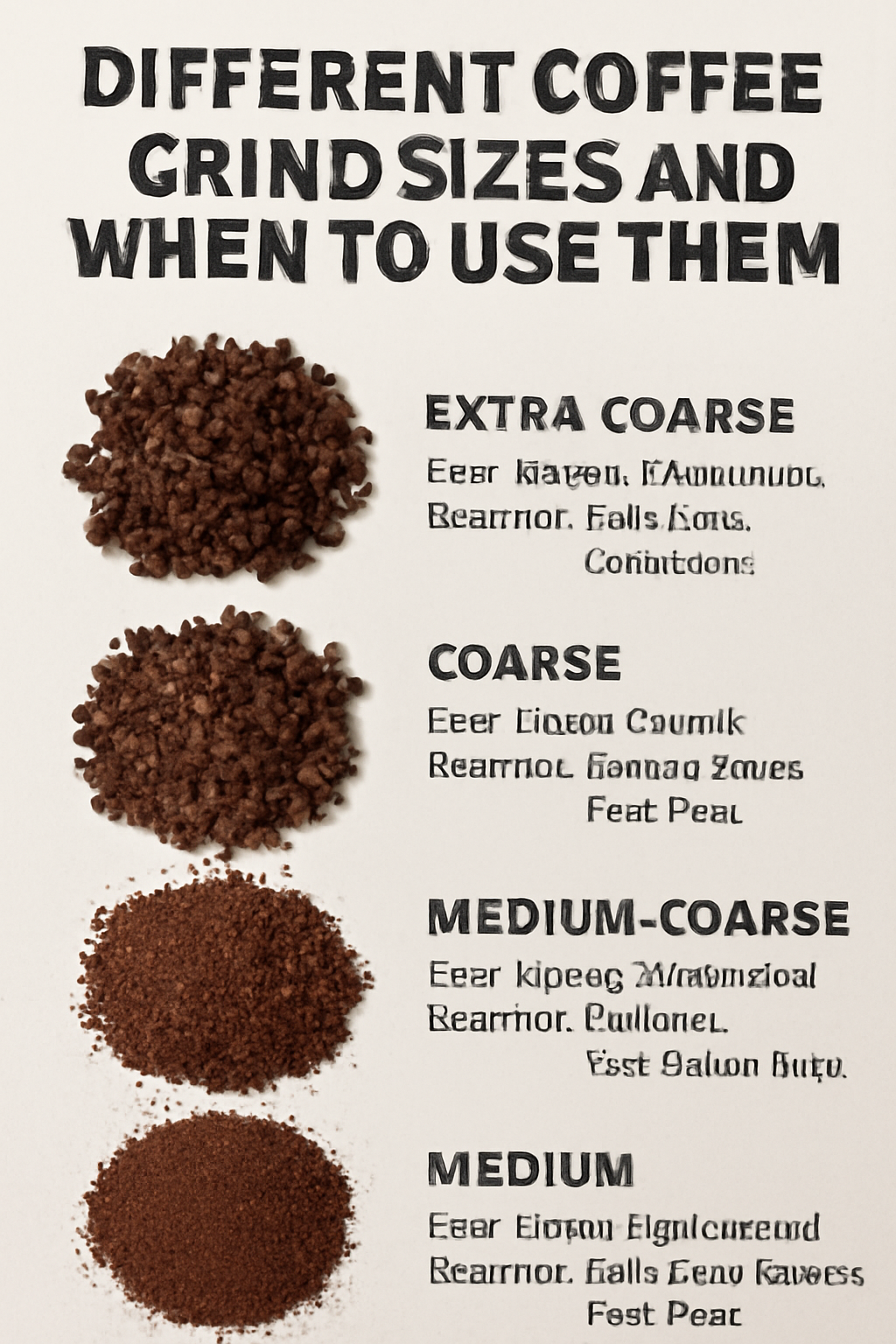Understanding the different coffee grind sizes and when to use them is crucial for brewing the perfect cup. Grind size directly affects extraction, flavor, and overall coffee quality. Whether you’re making espresso, drip coffee, French press, or cold brew, choosing the right grind size ensures your coffee tastes balanced and delicious. This comprehensive guide explores various grind sizes, their characteristics, and the best brewing methods for each.
Why Grind Size Matters
Grind size controls how quickly water extracts flavors from coffee grounds. Smaller particles have more surface area, extracting flavors faster, while larger particles extract slower. If the grind is too fine for your brewing method, water may over-extract coffee, resulting in bitterness. Conversely, if the grind is too coarse, under-extraction leads to sour, weak coffee.
Choosing the correct grind size maximizes flavor extraction, creating a balanced cup with the desired strength, acidity, and body.
Overview of Coffee Grind Sizes
Coffee grind sizes range from extra coarse to extra fine. Each grind size suits specific brewing methods due to variations in extraction time and water contact.
Extra Coarse Grind
Extra coarse grounds are large and chunky, resembling peppercorns or rock salt. This grind size is used for:
- Cold Brew: Steeped for 12-24 hours in cold water, requiring coarse grounds to prevent over-extraction and sediment in the final brew.
- Percolators: Uses a cycling brewing method where water passes through coffee repeatedly. Extra coarse prevents clogging and bitter flavors.
Extra coarse grind produces a smooth, mellow coffee with low acidity and bitterness.
Coarse Grind
Coarse grind looks like sea salt and is used for methods requiring longer extraction times:
- French Press: Coffee grounds steep in water for 4-5 minutes before pressing. Coarse grind allows proper extraction without over-extraction or clogging the mesh filter.
- Cold Drip: Similar to cold brew but uses slow dripping water. Coarse grounds ensure even extraction over several hours.
Coarse grind yields rich-bodied coffee with balanced flavors and a heavier mouthfeel.
Medium-Coarse Grind
Medium-coarse grind resembles rough sand and suits drip coffee makers and pour-over devices with slower water flow:
- Chemex: Uses thick filters and slower pour-over. Medium-coarse grind prevents clogging and allows balanced extraction.
- Flat-Bottom Drip Coffee Makers: Like some automatic brewers that use flat-bottom baskets.
This grind offers clean flavors with moderate body and brightness.
Medium Grind
Medium grind has a texture similar to regular sand and is one of the most versatile grind sizes. It is ideal for:
- Drip Coffee Makers: Cone-shaped filter drip machines require medium grind for optimal water flow and extraction.
- Pour-Over Brewers (e.g., Hario V60): Provides control over extraction, balancing brightness and body.
- Siphon Coffee Makers: Uses vacuum pressure and requires medium grind for consistency.
Medium grind produces balanced, clean cups with bright acidity and well-rounded flavor.
Medium-Fine Grind
Medium-fine grind looks like table salt grains and is used for faster extraction methods needing more surface area:
- Aeropress: Depending on brewing time and technique, medium-fine grind suits quick extraction methods.
- Cone Drip with Fast Pour: Allows quick water flow while ensuring extraction.
This grind provides vibrant flavors with slight acidity and smooth body.
Fine Grind
Fine grind is similar to granulated sugar and is the go-to for espresso machines:
- Espresso: Requires high pressure to force water through tightly packed grounds. Fine grind ensures sufficient resistance and flavor extraction within 25-30 seconds.
- Moka Pot: Uses steam pressure to push water through grounds. Fine grind yields strong, rich coffee.
Fine grind produces intense, concentrated flavors with a thick body and crema in espresso.
Extra Fine Grind
Extra fine grind resembles powdered sugar or flour and is used primarily for:
- Turkish Coffee: Boiled with water and coffee grounds unfiltered. The ultra-fine grind allows maximum flavor extraction.
This grind produces strong, bold coffee with a unique texture and intense aroma.
Matching Grind Size to Brewing Method
Selecting the right grind size depends on your brewing equipment and method. Here’s a quick reference:
- Extra Coarse: Cold brew, percolator
- Coarse: French press, cold drip
- Medium-Coarse: Chemex, flat-bottom drip coffee makers
- Medium: Drip coffee makers, pour-over, siphon
- Medium-Fine: Aeropress, fast pour-over
- Fine: Espresso, moka pot
- Extra Fine: Turkish coffee
How to Adjust Grind Size for Taste
Even within a brewing method, slight grind adjustments can improve flavor:
- If coffee tastes sour or weak, grind finer to increase extraction.
- If coffee tastes bitter or harsh, grind coarser to reduce extraction.
Regularly calibrate your grinder and adjust based on bean freshness, roast level, and brewing time.
Importance of Consistent Grind Size
Uniform grind size is vital for balanced extraction. Uneven grounds cause over-extraction of fine particles and under-extraction of coarse ones, leading to inconsistent flavors.
Use a quality burr grinder rather than a blade grinder to achieve consistent particle size.
Tips for Grinding Coffee
- Grind just before brewing to preserve freshness.
- Clean your grinder regularly to prevent buildup and contamination.
- Experiment with grind size and brewing parameters to find your preferred taste.
Conclusion
Mastering coffee grind sizes and knowing when to use each is key to brewing excellent coffee. By understanding the relationship between grind size, brewing method, and extraction, you can enhance flavor, balance, and body in every cup.
Experiment with different grind sizes, adjust based on taste, and invest in a good grinder for consistent results. Your perfect coffee is just a grind away.

